Specifications
Nissan VEJ30, V8 (90o) cyl, 4 stroke, petrol engine 2996cc, 85 x 66 mm 800 hp Aluminum-alloy block and head forged steel crankshaft with 5 main bearings DOHC, 4 Valves/cylinder - 32 valves total aspiration, 2 x IHI turbochargers with multipoint electronic fuel injection firing order 1 - 8 - 7 - 3 - 6 - 5 - 4 - 2 dry sump March 87T, 5 speed Manual gearbox aluminum monocoque chassis suspension (fr/r) double wishbones, coil springs over dampers, anti-roll bar rack and pinion ventilated disks 356mm disk diameter with 4 piston calipers all around Length 4780 mm (188.2 in) Width 1990 mm (78.3 in) Height 965 mm (38 in) Wheelbase 2800 mm (110.2 in) Track (fr/r) 1600 mm (63 in) / 1550 mm (61 in) wheels, front 13x17", rear 14x19" tires, front 320/30R17", rear 350/40R19" 850 kg

Allard Motor Company Limited was a London-based low-volume car manufacturer founded in 1945 by Sydney Allard in small premises in Clapham, south-west London. Car manufacture almost ceased within a decade. It produced approximately 1900 cars before it became insolvent and ceased trading in 1958. Before the war, Allard supplied some replicas of a Bugatti-tailed special of his own design from Adlards Motors in Putney.
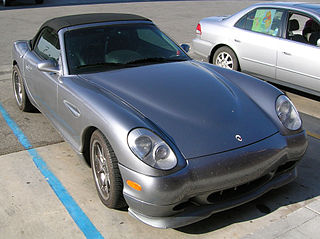
The Esperante is a sports car made by Panoz, an American car manufacturer.

The VK engine is a V8 piston engine from Nissan. It is an aluminum DOHC 4-valve design.
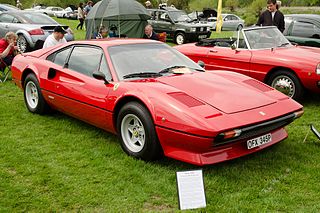
The Ferrari 308 GTB berlinetta and targa topped 308 GTS are V8 mid-engined, two-seater sports cars manufactured by the Italian company Ferrari from 1975 until 1985. The 308 replaced the Dino 246 GT and GTS in 1975 and was updated as the 328 GTB/GTS in 1985. The similar 208 GTB and GTS were equipped with a smaller, initially naturally aspirated and later turbocharged, two-litre engine, and were sold mainly in Italy.

Formula Renault are classes of formula racing popular in Europe and elsewhere. Regarded as an entry-level series to motor racing, it was founded in 1971, and was a respected series where drivers can learn advanced racecraft before moving on to higher formulas.
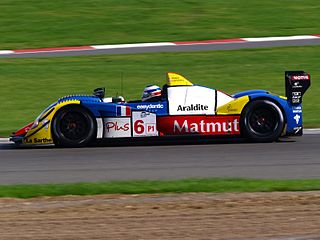
Courage Compétition was a racing team and chassis constructor company now owned by Oreca, based in Le Mans, France, near the Circuit de la Sarthe. It was founded by Yves Courage, a French race driver who ran hillclimbs before founding the company. Following the purchase of Courage by Oreca in 2007, Yves Courage has refounded the company as Courage Technology in 2010, attempting to develop electric racing cars.

The Nissan R390 GT1 was a racing car built in Atsugi, Japan. It was designed primarily to gain a suitable racing entry in the 24 Hours of Le Mans in 1997 and 1998. It was built to race under the grand touring style rules, requiring a homologated road version to be built. Therefore, the R390 was built originally as road car, then a racing version of the car was developed afterwards. Only one R390 road car was ever built and is stored at Nissan's Zama facility, although one of the race cars was later modified for road use. The road car was claimed to be capable of attaining a top speed of 354 km/h (220 mph). However, this claim has never been proven.
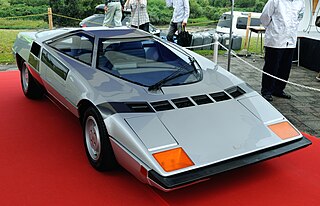
The Dome Zero was a prototype sports car from DOME Co. Ltd that was exhibited at the 48th Geneva Auto Show in 1978. The Dome project, pronounced "do-mu" or "child's dream" in Japanese, was started by Minoru Hayashi in 1975, with the goal of producing sports cars using knowledge gained from auto racing. The Zero was to be their first production road car and Dome planned to produce a limited number for sale in Japan. Despite multiple prototypes and homologation efforts, the Zero was never approved by regulatory bodies for sale in Japan or overseas. As a result, the project was not commercially viable and the Zero never entered series production.

Devin Enterprises was an American automotive manufacturer that operated from 1955 to 1964. Devin was mainly known for producing high quality fiberglass car bodies that were sold as kits, but they also produced automotive accessories as well as complete automobiles. The company was founded by Bill Devin.
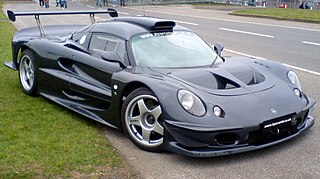
The Lotus Elise GT1 is a race car developed for grand tourer-style sports car racing starting in 1997.

The Chevrolet Corvette GTP was an American Grand Touring Prototype-class sports prototype racing car which successfully participated in the IMSA Camel GT from 1984 until 1989. The car was professionally fielded in competition as General Motors' Chevrolet Corvette C4 official factory team effort in the IMSA GTP class.
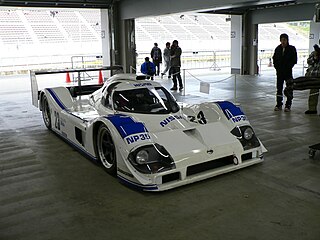
The Nissan P35 was a planned Group C car built by Nissan Motors for competition in the World Sportscar Championship. Developed by Nissan Performance Technology Inc. (NPTI), which had formerly raced under the name Electramotive in the United States, the cars were intended to be completed by the middle of 1992, with competition starting in 1993. However economic troubles for Nissan led to the cancellation of the project soon after testing of the first cars had begun, meaning that the P35s never raced.
G-Force Technologies was an American racing car manufacturer originally formed by Americans Chip Ganassi and Ken Anderson in 1991. Ganassi would leave the company early on and the company was renamed G Force Precision Engineering. The company built successful cars in the Indy Racing League and 24 Hours of Le Mans. G-Force race cars won 4 Indianapolis 500s and 2 IRL Championships. G-Force was purchased by Élan Motorsport Technologies in 2002 and all manufacturing was moved to Elan's facilities in Braselton, Georgia. Ken Anderson would leave to form Falcon Cars with Michael Kranefuss to build a competing chassis for the 2004 IRL season. Former Lola designer Simon Marshall would be brought on to design its new IRL chassis for 2003 which was branded the Panoz G-Force. During the winter of 2004, all remaining G-Force operations in England were moved to Braselton, and the England operations of G-Force were shut down. By the start of the 2005 season, the G-Force name was retired.

The Aston Martin Vantage GT2 is the most powerful racing variant of the Aston Martin V8 Vantage family. The Vantage GT2 is based on the V8 engined Aston Martin Vantage road car but is designed to run on both standard race fuel or E85 bio-ethanol.

The Nissan VRH engine family consists of several racing engines built by Nissan Motor Company beginning in the late 1980s. All VRH engines are in a V8 configuration, with either natural aspiration or forced induction. Some VRH engines are loosely based on Nissan's production V8 engine blocks, including the VH and VK engines, while others were designed from the ground up for racing and share no components with production blocks.
The Audi R8 LMS Cup was a one-make sports car racing series by Audi based in Asia. Audi R8 LMS Cup cars were based on the Audi R8 LMS (GT3).

The Ferrari SP was a series of Italian sports prototype racing cars produced by Ferrari during the early 1960s. All featured a rear mid-engine layout, a first for a Ferrari sports car. Major racing accolades include the 1962 European Hill Climb Championship, two overall Targa Florio victories, in 1961 and 1962, and "1962 Coupe des Sports" title.
The Nissan VEJ30 is a 90-degree, turbocharged, four-stroke, gasoline-powered, sports car racing engines, built by Nissan Motor Company, in the 1980s. All VEJ30 engines are in a V8 configuration, and use forced induction turbocharging.

The Abarth 3000 Sport Prototipo was a sports car prototype made by Abarth & C. in Turin, Italy. It was the first Abarth with an engine with a capacity of more than 2-liters, after an already finished 6-liter twelve-cylinder from 1967 had become useless before it could be used due to a change in the regulations. The displacement for sports car prototypes was limited to 3 liters and for sports cars to 5 liters.
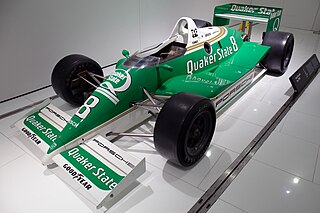
The Porsche 2708 is an open-wheel race car made by Porsche to compete in CART Indy car racing, between 1987 and 1990.
















